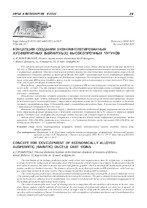| dc.contributor.author | Покровский, А. И. | ru |
| dc.coverage.spatial | Минск | ru |
| dc.date.accessioned | 2023-01-20T11:32:59Z | |
| dc.date.available | 2023-01-20T11:32:59Z | |
| dc.date.issued | 2022 | |
| dc.identifier.citation | Покровский, А. И. Концепция создания экономнолегированных аусферритных (бейнитных) высокопрочных чугунов = Concept for development of economically alloyed ausferritic (bainitic) ductile cast irons / А. И. Покровский // Литье и металлургия. – 2022. – № 4. – С. 29-37. | ru |
| dc.identifier.uri | https://rep.bntu.by/handle/data/125266 | |
| dc.description.abstract | Рассмотрена материальная структура производства отливок в мире, общие объемы выпуска которых превысили 112 млн. т. Показана ведущая доля чугунов и, в частности, рост выпуска высококачественных и высокопрочных чугунов с шаровидным графитом. Описана устойчивая тенденция замены для ответственных машиностроительных изделий легированного стального проката на Austempered Ductile Iron (ADI) – высокопрочный чугун с шаровидным графитом, изотермически закаленный на аусферритную (бейнитную) структуру. Рассмотрена динамика цен на основные легирующие элементы ADI-чугунов (молибден, никель и медь, суммарное количество которых в сплаве достигает 5 %) и показано, что ее рост устойчиво положительный. Цель работы – разработка концепции экономного легирования ADI-чугунов (суммарное содержание молибдена, никеля и меди – не более 2 %), при котором сохранялась бы удовлетворительная прокаливаемость и одновременно снижалась себестоимость. Указанная цель реализовывалась путем снижения до минимума содержания наиболее дорогого элемента – молибдена. Пониженное содержание основной «триады» легирующих элементов компенсировали микродобавками стронция (бария), ванадия, бора, ниобия, добавками мишметалла. Предложено несколько групп экономнолегированных чугунов: 1) низконикелевый и низкомолибденовый с повышенным содержанием меди (до 1,8 %) и добавками ванадия; 2) безмолибденовый с микродобавками бора; 3) безмолибденовый с микродобавками ниобия и бора; 4) полностью безмолибденовый с минимальным легированием никеля и меди. Показано, что обработка давлением наряду с приданием изделию необходимой формы оказывает влияние на кинетику структурно-фазовых превращений и действует аналогично легированию Mo и Ni, сдвигая С-образную кривую вправо. Следовательно, аусферритную структуру можно получить при меньшей скорости охлаждения. Механические свойства при таком легировании и использовании пластической деформации составляют: предел прочности 1100–1500 МПа, относительное удлинение – 2–4 % (нижний бейнит), предел прочности 800–1100 МПа, относительное удлинение – 4–7 % (верхний бейнит). | ru |
| dc.language.iso | ru | ru |
| dc.publisher | БНТУ | ru |
| dc.title | Концепция создания экономнолегированных аусферритных (бейнитных) высокопрочных чугунов | ru |
| dc.title.alternative | Concept for development of economically alloyed ausferritic (bainitic) ductile cast irons | ru |
| dc.type | Article | ru |
| dc.identifier.doi | 10.21122/1683-6065-2022-4-29-37 | |
| local.description.annotation | The distribution of the castings production in the world, whose total output is more than 112 million tons, is considered. A steady trend to the replacement of rolled alloy steel, which is used for critical engineering products, by Austempered Ductile Iron (ADI) is outlined. The latter is ductile cast iron with globular graphite, which is austempered (isothermally quenched) to produce ausferritic (bainitic) structure. The dynamics of prices for main alloying elements in ADI (molybdenum, nickel and copper, whose total amount in the alloy reaches 5 %) is considered and their steady growth is outlined. The research goal is to develop a concept of economical alloying of ADI (the total content of Mo, Ni and Cu should not exceed 2 %) retaining sufficient hardenability and substantially decreasing the cost price. The goal is attained by decreasing the content of the most expensive alloying element, molybdenum, to a minimal level along with the use of microalloying and applying one of the methods of hot plastic deformation to the casting. The reduced content of the main ‘triad’ of alloying elements is compensated by microadditives of strontium or barium, vanadium, boron, niobium and the addition of misch metal. Several groups of economically alloyed cast irons are proposed: (1) low-nickel and low-molybdenum with increased content of copper (up to 1.8 %) and the addition of vanadium, (2) molybdenum- free with microadditive of boron, (3) molybdenum-free with microadditives of niobium and boron, and (4) molybdenum-free minimally alloyed with nickel and copper. It is shown that plastic deformation, along with giving the product the required shape, affects the kinetics of structural-phase transformations. and acts similarly to alloying with Mo and Ni, shifting the TTT-curve to the right. Therefore, the ausferritic structure can be obtained at a lower cooling rate. The mechanical properties with such alloying and the use of plastic deformation are the following: ultimate tensile strength 1100–1500 MPa and elongation to failure 2–4 % for lower bainite; ultimate tensile strength 800–1100 MPa and elongation to failure is 4–7 % for upper bainite. | ru |

